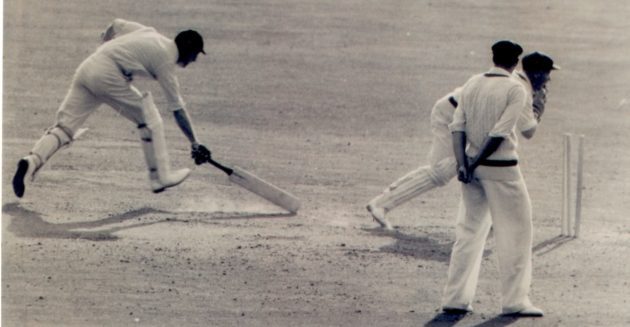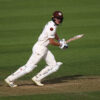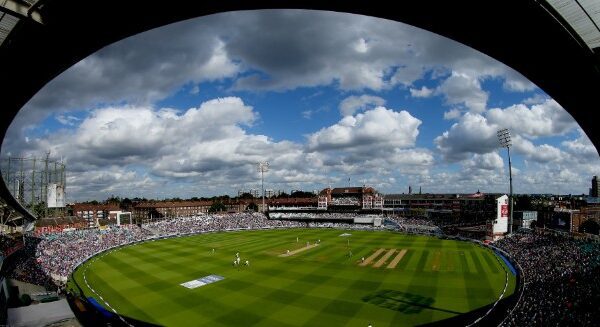A new year awaits and there are historic echoes from 70 years ago for Surrey, England and The Kia Oval. Richard Spiller explains
The prospect of an Ashes summer ahead always quickens the pulse, which makes the arrival of 2023 all the more welcome.
Can England win back the urn which Australia took decisively down under in 2017-18, retained in England in 2019 and kept with embarrassing ease last winter?
Usually, Ashes clashes dominate the domestic schedule but the 2023 series sees five matches squeezed into June and July. One tradition which remains is that it will culminate at The Kia Oval. Walk around the ground and you will easily find reminders of past encounters.
The new year marks the 70th anniversary of one of those classics – England winning back the Ashes in 1953, a nip and tuck summer in which Len Hutton and Lindsay Hassett’s teams both had their opportunities in the first four matches but it remained 0-0 going into the final match. Another draw would have ensured Australia – no longer led by Don Bradman but still featuring several greats, including fast bowlers Ray Lindwall and Keith Miller – remained in possession.
England’s win by eight wickets capped a tumultuous sporting year which had included the Matthews cup final and Gordon Richards winning The Derby, all against the background of the coronation of Queen Elizabeth II.
“Is this the Ashes? Yes, England have won the Ashes!”
Even if you were not at The Oval – and given it’s now 70 years on, most of us won’t have been – then you have probably seen the grainy footage of Denis Compton pulling Arthur Morris to the boundary, Brian Johnston excitedly hailing the long-awaited triumph.
Winning them back was a moment of enormous excitement given the Australians had been in possession since 1934, when they had sewn up the series 2-1 at The Oval by an awesome 562 runs. They never looked like relaxing their grip while Bradman was wrecking the career records of whoever came up against him, each side of the Second World War. Even in the 1950-51 series, after Bradman had retired, Hassett’s men won 4-1 with just a win in the final game giving England hope of better times ahead.
By the time Hassett and his men arrived in England in 1953, much had indeed changed, even if post-war rationing continued. The death of King George VI the previous year meant 1953 would include the coronation and those celebrations marked it out as a special year, much as everyone hopes will be the case in 2023.
The tone was set by the Matthews cup final, which pitted Blackpool against Bolton Wanderers in the FA Cup final at Wembley. Stanley Matthews, one of England’s greatest players, was still missing a winner’s medal after being on the losing side in 1948 and 1951 and it was thought that this might be his final chance at the age of 38.
He was in danger of missing out again when Blackpool went 3-1 down but Matthews showed the wing wizardry which had made him such a legendary figure, turning the match around. Although team-mate Stan Mortensen scored a hat-trick, the 4-3 victory earned by Blackpool would always be associated with a man still playing top level football at 50 and knighted before he retired.
Another great sporting moment came in the days following the coronation, at Epsom. Gordon Richards, champion jockey for all but one year since 1931, had not won The Derby in 27 attempts and time was running short for him too. But now he guided Pinza over the line first, beating the Queen’s horse Aureole, ridden by Harry Carr. Happily the newly-crowned monarch did not take it personally, congratulating him moments later and knighting him later that month.
Cricket too had something to celebrate when Surrey’s own Jack Hobbs was knighted, the first professional player to be recognised and a worthy recognition for not only a great player – he had scored 61,760 first-class runs and played 61 Tests – but a man known for his kindness and integrity.
Surrey started the season as county champions, having won the title outright for the first time since 1914, and Stuart Surridge’s men began the campaign in formidable style. They beat Warwickshire inside a day at The Oval, only the second time it had been achieved. Alec Bedser’s 8-18 ensured the visitors were dismissed initially for 45 on a drying pitch.
Batting was never straightforward, Bernie Constable’s 37 and late hitting from Tony Lock (27) seeing Surrey to 146 before Bedser (4-17) and Jim Laker got to work again. The off-spinner devastated the middle-order, including a hat-trick among his 5-29 to bowl out Warwickshire again for 52 to win by an innings and 49 runs.
It set the tone for Surridge’s side to retain the title by winning 13 of their 28 matches, finishing 16 points clear of runners-up Sussex.
When the Ashes began, at Trent Bridge in mid-June, Bedser was dominant as he claimed 14 wickets in the match. Even though England trailed by 105 on the first innings, it took rain washing out much of the final day to deprive them of a likely victory, having entered it needing 187 with nine wickets in hand.
Moving on to Lord’s, Hassett’s second century of the series was cancelled out by England skipper Len Hutton’s 145, his side taking a narrow lead. But after Miller’s 109 they were left needing 343 to win and slumped to 12-3 late on day four. When Compton departed the next morning, England seemed doomed, five hours play still remaining, yet they were saved by Willie Watson (109) and Trevor Bailey (71) mounting epic resistance.
The rain-hit third Test at Old Trafford was heading for a certain draw when Australia’s 318 – Bedser claiming 5-115 – was answered by 276 all out. Yet suddenly the tourists collapsed to 35-8 against Bedser (2-14) plus spinners Johnny Wardle (4-17) and Laker (2-11) before time ran out.
Australia were back on top at Headingley, dismissing the hosts for 167 and earning an advantage of 99 before coming up against the resistance of Compton (61), Bailey (38) and tailender Laker (48). Even then they needed 177 in an hour and 45 minutes, time-wasting tactics frustrating them so that the chase finished at 147-4.
That meant everything now hung on the final Test at The Oval, an extra day being added to boost the chances of a result. Expectation of massive crowds put off many on the first day, Saturday August 15, so that it was played in front of 26,500, just under capacity.
Among the spectators missing that opening day was future prime minister John Major, who attempted to buy a ticket from a tout but found the “premium was beyond my means”. He had to settle for listening on the radio, although ball-by-ball coverage was still four years away and television showed only the final session in full.
Wardle’s late haul at Old Trafford had not saved him from being replaced at Headingley by fellow left-arm spinner Lock and now Surrey’s representation in the side swelled to four with the recall of Peter May alongside Bedser and Laker. Just as importantly, England strengthened their bowling by calling up Yorkshire paceman Fred Trueman. He was soon in action as Hutton lost the toss for the fifth time, claiming 3-88 to Bedser’s 4-86 as Australia were dismissed for 275, built around Hassett (53) and Lindwall’s 62 down the order.
Much depended, as so often in the post-war years, on Hutton and he had a narrow escape in the opening over of the reply when his cap fell off and just missed the stumps.
The gates were shut well before the resumption on Monday morning and Hutton needed every ounce of his expertise in making 82, May’s 39 helping add 100 for the second wicket. The tourists had made an error by omitting a specialist spinner, relying on left-arm seamer Bill Johnston to deliver his slower variety and seeing him make a vital breakthrough in bowling Hutton at 154-3. Lindwall (4-70) utilised the second new ball effectively so that England were grateful to Bailey’s typically staunch 64 and a last wicket partnership worth 40 with Bedser (22no) to reach 306 the next morning.
It was on that third day that the Ashes were effectively decided. Hutton quickly removed his pacemen and switched to spin, Laker gaining the breakthrough by having Hassett leg-before in the veteran’s final innings at Test level. Relishing their home conditions, Surrey’s spin twins reduced Australia to 61-5 inside an hour and continued to work their way through the rest. They were held up only by Ron Archer’s spirited 49, Lock taking top billing as he claimed 5-45 and Laker collecting 4-75.
Finishing off their opponents for 162, England had 45 minutes plus three days to win the Ashes, Hutton ran himself out for 17 as his side closed at 38-1 and they would have to fight for those last 94 runs. It took them into the second session, the tension relished by another massive crowd. May proved Keith Miller’s final victim of the campaign, for 37, and at 2.53pm the Ashes finally returned to England.
Speeches from Hutton and Hassett entertained a crowd, who had poured across the outfield and were in no hurry to go home.
Since then, there have been more great Ashes moments at The Oval, David Gower’s side winning them back in 1985, Michael Vaughan’s in 2005 and Andrew Strauss’s four years later.
Will there be another moment to savour in 2023?









